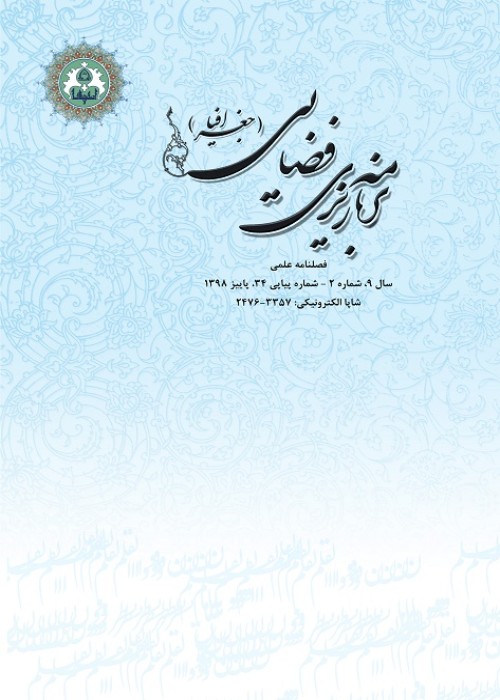Spatial Distribution of Quaternary ELA in Iran Geomorphic Units
Author(s):
Article Type:
Research/Original Article (دارای رتبه معتبر)
Abstract:
Interodaction
Geomorphologic evidence and existing landforms, such as glacial cirques, glacial valleys, glacial erratic, and tiles, indicate the performance of glacial processes and the dominance of glacial systems. Among the basic issues in glacial studies are the ELA and the water and ice equilibrium line (Ramesht et al. 2011). Although the current situation in Iran and the domination of dry and semi-arid conditions have led to doubt about the existence of glacial rule in this country, but the glaciers geomorphologic evidence in the different regions of Iran shows the performance of glaciers. Iran, with an area of 1648195 square kilometers, is located between 25 to 40 degrees north latitude and 44 to 63 degrees east longitude. It is geometrically similar to a diamond that has a large diameter along the northwest - southeast and its small diameter is along the northeast - southwest. The average length and width of Iran along the meridian of 54 degrees east and 32 degrees north is about 1225 kilometers. The political range of Iran in arid areas is more consistent with local geographic complications, the most important of which is the Thalweg along the watercourse, which is divided into 6 geomorphic units (i.e. Zagros, Northern, Central Iran, and Eastern, Northeastern, and Northwestern units).
Material and methodes
Study of Equilibrium-Line-Altitude (ELA) in Iran, as an independent unit, is not flawless since it is expanded 15 degrees latitude and 19 degrees longitude. To do this, an Iranian DEM with 30*30 meter resolution was first prepared from the USGS site and merged in the ARC GIS software, and the related DEM was cut for each unit. Merged topographic maps of Iran with a scale of 1: 50000 were also extracted for each unit. Based on documents in topographic maps, 20-meter equilibrium lines and the reflection of landforms in SRTM satellite images, cirques of each peak were identified. Topographic maps deal with virtual displays of terrains, and the four elements of the form of contour line, the arrangement of peaks and the network of streams, and single elevation points make this identification easier. The form of contour lines can be used to determine the areas dominated by icy zones on the map and satellite imagery. In the next step, the data of the cirques identified alluvial sediments that have not undergone diageneses or erosion-sensitive sediments such as marl and clay was extracted from the cirques data. Then, according to the method of Terminus-to-Head Altitude Ratio the identified cirque that were not concave with a longitudinal profile design were considered as pseudo-cirques and were discarded in the estimation of the ELA. ELA was calculated using Wright and cirque-floor altitude methods. The overall direction of the identified cirques was determined according to the continuity of terrains, so that the main ridge of each basin determined the direction of the formation of the cirque. In addition, according to the slope direction maps and sampling from cirques points, the direction of the cirques was identified.
Results and discussion
The result of the ELA of the 13th highest peak of Iran is as follows: Boll 2946m, Alvand 2700m, Tochal 2691m, Hezar 2936m, Binalud 2529m, Damavand 2832m, Sardasht 2719m, Boghrudagh 2026m, Shaho 1997m, Sabalan 2872m, Belgheis 2621m, Shirkouh 2959m and Zardkuh 2862m.The difference in ELA of Zagros unit, which is more extended in latitude, was estimated to be 842 m. ELA of northeast slopes was estimated to be 685 m above ELA of the southwest slopes. In the central geomorphic unit of Iran, as the most arid units under the influence of glacial processes during the quaternary, cirque-floor altitude method and THAR (Wright) are the most suitable methods for estimating ELA. In this geomorphic unit, estimated ELA varies between 2772 m and 2915 m (143 m altitude difference). The quaternary ELA of this unit is 2902 m, which is the highest ELA among the geomorphic units of Iran. In terms of direction in this geomorphic unit, altitude difference of north-northeast and south-southwest slopes was 143.5 m. The estimated ELA of Al-Madrasi and Ramesht (2007) in the Sakhvid sub-basin (3300-3100 m), Jafarbeiglo et al. (2014), and Zahab Nazouri et al. (2016) in Bidkhan sub-basin of Kerman (3166 m) on south-southwest slope, and Parizi et al. (2013) in Tangoeye Sirjan (2719 m) in south-southeast slope of the mountains of the Central Iran unit are in line with the findings of this research.
Conclusion
Quaternary climatic changes and the displacement of ELA in the mountainous regions of Iran are inevitable and obvious. Accordingly, the effects of the Quaternary glaciers are identified in the second grade basins of Iran. The ELA is estimated by Wright, cirque-floor altitude, THAR (of Wright and Porter), and altitude ratios's methods. Cirques’ landforms are usually identified with the help of contour lines and satellite imagery. Due to the fact that landforms in loose lithology cannot remain unchanged for a long time, the data of those landforms that were considered as cirques in loose sediments and those that have not undergone diagenesis were removed. Removing information of these cirques suggests that these semi-cirques landforms are located at lower altitudes in most of the basins. With respect to the effect of land surfaces’ slope direction of the formation of cirque landforms in temperate regions, the estimated ELA cannot be trusted without regard to the direction of land slope. Accordingly, in addition to Wright's method, cirque-floor altitude, THAR method (of Wright and Porter), and altitude ratios are used for estimating ELA in different geographical directions. In most of Iran basins, ELA estimated by Wright’s method was 200 m higher than the rest of the methods. Porter (2001) believes that the difference in ELA with different methods is because of different methodologies, but the great difference between Wright's method and other methods suggests that the method is not consistent with them. As a result, it can be said that the ELA estimated by Wright method cannot be trusted in all parts of IranKeywords:
Cirque , Glacier , Geomorphic unit , Iran , Quaternary
Language:
Persian
Published:
spatial planing, Volume:8 Issue: 2, 2018
Pages:
81 to 104
magiran.com/p1893078
دانلود و مطالعه متن این مقاله با یکی از روشهای زیر امکان پذیر است:
اشتراک شخصی
با عضویت و پرداخت آنلاین حق اشتراک یکساله به مبلغ 1,390,000ريال میتوانید 70 عنوان مطلب دانلود کنید!
اشتراک سازمانی
به کتابخانه دانشگاه یا محل کار خود پیشنهاد کنید تا اشتراک سازمانی این پایگاه را برای دسترسی نامحدود همه کاربران به متن مطالب تهیه نمایند!
توجه!
- حق عضویت دریافتی صرف حمایت از نشریات عضو و نگهداری، تکمیل و توسعه مگیران میشود.
- پرداخت حق اشتراک و دانلود مقالات اجازه بازنشر آن در سایر رسانههای چاپی و دیجیتال را به کاربر نمیدهد.
In order to view content subscription is required
Personal subscription
Subscribe magiran.com for 70 € euros via PayPal and download 70 articles during a year.
Organization subscription
Please contact us to subscribe your university or library for unlimited access!



